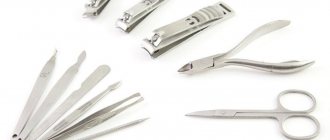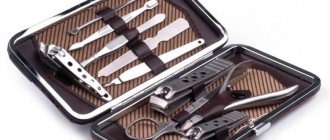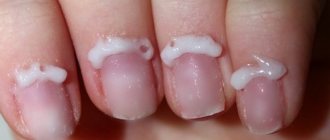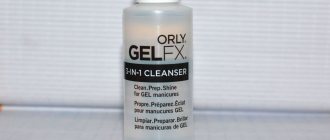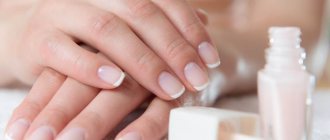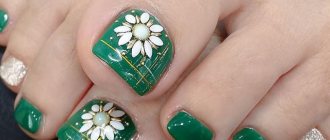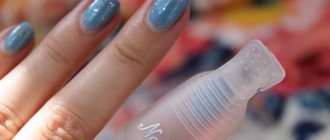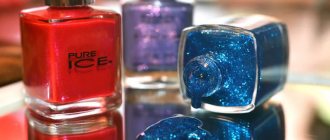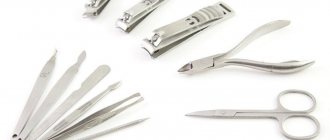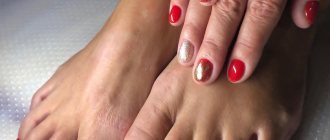What is abrasiveness?
The word “abrasiveness” refers to the hardness of the nail file. High-quality treatment of the nail plate largely depends on the degree of rigidity with which the file is chosen. After all, if it does not meet the norm, you can damage the nail.
How is the abrasiveness of files measured? Usually in grits. This unit of measurement clearly demonstrates the accumulation of those same abrasive particles on the surface of the manicure tool used. The lower the indicator, the greater the rigidity.
It is not advisable to choose a nail file simply by eye; it is better to decide what exactly it is needed for. This makes it easy and hassle-free to select the appropriate degree of hardness.
How to file square nails correctly?
Along with the almond shape, the square shape remains one of the most popular. Such nails suit almost all fingers, thin and full. Both French manicure and any other design look great on these nails. It is much more difficult to give a square shape to natural nails than to nail extensions, but it is quite possible.
square nails
Technology for creating square nails:
- Get a quality manicure: remove polish from the surface of the plate, clean the nail, remove cuticles and hangnails
- The length of the nail should be shortened to the desired size, while trying to make the line as even as possible and along the longitudinal axis of the finger
- You should start filing your nail, holding the file parallel to your finger so that the side is as even as possible.
- This type of sawdust is repeated on the opposite side of the finger.
- Make a horizontal file on the nail, giving it a square shape.
- There are three types of square nails: sharp square, soft square, round square. Each shape depends on how smoothly you cut the sharp corners on the sides
The value of the abrasiveness number of nail files
Surely many have noticed more than once a certain set of numbers on each file: for example, 180/240. How can this be explained? It’s simple, this means that on one side the file has 180 abrasive particles, and on the other there are 240. And these indicators are precisely grits. For example, what is a 180/240 file intended for?
This can be found out by analyzing several specific groups into which nail files are divided according to their indicators:
- 60–80 grit is a hard nail file. These files are primarily intended for adjusting the length of artificial nail plates. It is better to avoid treating natural nails with such files. If this is not done, the result may be delamination.
- 100–150 grit - such a file will have a slightly lower degree of hardness. A working tool with such indicators is used to adjust artificial nails, and with its help you can give it any shape.
- 150–240 grit – medium hardness. However, it cannot be used for natural nails either, only for artificial ones. Usually, with the help of such a file, the final shape of the nail plates is made and the necessary alignments are made.
- 240 grit is a high abrasiveness of files for natural nail plates.
- 240–400 grit – soft nail file. It is used to correct nails and also polish them.
- 400–900 grit - a file with a similar indicator may well be useful in preparing nails for polishing.
- 900–1200 grit – these can be microabrasives and buffs, which are designed to polish the nail plate to a mirror shine.
Types of manicure files
Nail files vary in shape, material and hardness. Don't know which one is right for you? We will show you how to choose the nail file you need.
A nail file is an important tool in a manicurist’s arsenal. Using a file, you can give your nails the desired shape, cut off excess length and polish the surface of the nail plates to a shine.
Types of nail files
The first thing you should pay attention to when choosing a nail file is the material from which it is made.
- Disposable files consist of multi-layer cardboard or polystyrene foam coated with fine quartz, Teflon or granite chips. This is ideal for one-time use in the salon. It should be taken into account that such files cannot be washed and sterilized, as they can deteriorate under the influence of high temperature and moisture. Therefore, they can be used only once or have a separate, individual set in stock for each client. Considering their low cost, this is beneficial and does not present much difficulty. Plastic and wood-based files also cannot be sterilized, but they are slightly more durable than disposable files.
- Files with a wooden base have a rigid structure, do not bend and are very easy to use. They can be disinfected in liquid solutions, which allows them to be reused many times for individual use.
- Metal files can serve you for several years without replacement. They are not recommended for filing peeling and brittle nails, as this can lead to even greater delamination. But they do an excellent job of forming extended nails. Therefore, every master needs to have a metal file in his arsenal. It can be sterilized in any way, including dry heat.
- Glass files have won the love of many manicurists. They are more gentle on nails, carefully file the nail plates and allow you to carefully form the desired length. They can also be sterilized in all ways: glass is resistant to high temperatures and chemicals.
- Ceramic files are the most suitable option for thin, brittle and flaking nails. They are quite soft and gently file natural nails without allowing them to peel. In addition, you can use a ceramic file to treat the skin around your nails.
- Laser files are know-how in the world of manicure tools; they appeared not so long ago. This is an ultra-modern answer to the problem of peeling nails! The laser file “seals” the edges of the nail plate, thanks to which the nails maintain a healthy appearance and do not peel off.
Abrasiveness of files. What do grits mean?
The abrasiveness (hardness) of files is measured in grit. The more grit, the finer the file is sprayed and the softer it is. Depending on the hardness, nail files are divided into several types.
80-150 grit – hard files for artificial nails. They are used to file only artificial nails; they are not recommended for use on natural nails. These files can easily handle tips and nail extensions with gel and acrylic.
150-240 grit – soft files for natural and artificial nails. Natural nail plates are delicately filed and are suitable for forming an arch on artificial ones.
240-500 grit – grinders and buffs. Gently lift the scales of the nail plate. Serve for polishing nails before coating with gel polish or extensions, for better adhesion of the material to the surface of the nail.
900-3000 grit – highly abrasive polishers. Essential for giving nails a glossy shine. Polishers are used to treat acrylic nails after extensions, and in some cases - for natural nails.
If your file shows two numbers, for example, 180/240 grit, this means that one surface is softer and the other is harder. Buffs can have up to 6 working surfaces with different abrasiveness. And the unique block from Zinger can be a file, a grinder, and a polisher at the same time - amazing versatility!
Nail file shapes
The files also differ in shape. But this is a subjective matter: who likes and is comfortable working with what.
Straight shape
Classic straight files usually have the shape of a regular rectangle. They are useful for many types of work.
Arc (boomerang, banana)
Thanks to its smooth shape, this file is easy and convenient for beginners to work with. It will help to form a correct and smooth nail contour.
Buff (block)
Their main advantage is versatility. Typically, buffs are suitable for both natural and artificial nails.
Files and buffs Smart
Life hack for craftsmen - Smart files and buffs with replaceable files. The files are attached to a metal base. You can change the working surface of the file whenever you need it. The bases can be of different shapes and lengths: each master chooses the most convenient one for himself. Files on a foam backing have different abrasiveness from 100 to 320 grit. New generation Smart files are an easy and practical way to always have a supply of files for each client.
Files with replaceable SMART files
How to file your nails correctly?
To keep your nails from peeling and to be healthy, you need to file them correctly: strictly in one direction, avoiding movements in different directions. Do not file wet or steamed nails; at least 4 hours must pass after bathing or showering.
If you want to be a successful manicurist and easily cope with any task that arises during work, you need to understand the types, shapes and abrasiveness of nail files. And, of course, all types of files, grinders and polishers should be in your arsenal.
We wish you successful work!
Best regards, imkosmetik online store.
Measuring the abrasiveness of a file for natural nails
So, what kind of files are needed for natural nails? Typically, the abrasiveness of nail files should be 180/240 grit. However, it is best to stick to another indicator - 240. What is the reason for this? If the degree of rigidity is high, this means that the file will have a gentle effect on the nail plate.
Typically, a high index file can be used for polishing, but not for correction. If the hardness of a manicure tool starts from 900 grit and ends at 1200, this means that it is more suitable for grinding.
How to file your nails if you don’t have a file?
There are situations when a nail breaks suddenly, and there is simply no special file at hand. If you still have a lot of work ahead, you should find a suitable object that can smooth the edges of a broken nail instead of a file. For this you may find it useful:
- An ordinary coin, the side of which (edge) has a ribbed surface
- A brick wall is a gentle nail file, but it can cause your nails to turn red.
- Asphalt is a harder surface, but it is just as effective at eliminating sharp tips on the nail.
Take care of your nails on time, always monitor their shape and listen to the recommendations for filing at home. If you take care of the beauty of your nails, they will also delight you with their health and strength in any situation.
What is the abrasiveness of an artificial nail file?
If you take into account a file for artificial nails, in this case it is best to choose a tool with the least degree of rigidity.
In addition, if you want to shape your nails, then the file should have a value of no more than 100 grit. In the case of simple filing, use tools with an abrasiveness of 100 to 180 grit.
Japanese nail polish
Japanese manicure has gained popularity in Russia relatively recently. Polishing using this technology helps strengthen, heal and promote faster growth of the nail plate. Japanese manicure is not only a procedure for getting rid of cuticles and polishing, but is also aimed at the therapeutic restoration of nails.
This type of manicure is recommended to improve the condition of the nail surface after removing artificial nails. Procedures using this technology are performed using numerous natural materials. They contain: pearl crumbs, cucumber extract and beeswax.
The polishing block, which is used to perform Japanese manicure, is double-sided. The first side is abrasive, the second is suede, made of calfskin.
Japanese polishing process:
- Immediately before the procedure, a mineral paste containing useful substances is rubbed into the nail plate: marine peptides, pearl crumbs, keratin. With its help, all the smallest cracks on the plate are filled, as a result of which the nail becomes perfectly smooth.
- Next, the nail plate is polished.
- At the end of the procedure, beeswax is applied to the plate, which forms a protective thin layer. Due to this, the marigolds will be protected from various external influences and nourished with the necessary substances for a long time.
- After this manicure, the master massages the client’s hands using oil.
Brands of Japanese polishing kits: MASURA, Rio Profi Sakura, P-Shine.
Does the abrasiveness of nail files depend on the material?
As for the material from which nail files are usually made, it can be either artificial or natural.:
- Glass files are considered one of the best for correcting natural nails. And all because they do not cause any harm to the nails. In addition, such tools can be easily washed.
- Crystal manicure tools also cut very well. With them it is possible to create smooth and soft edges. Typically, such nails no longer require further polishing.
- Fabric files are usually flexible, and their middle part is synthetic, plastic or wood. This product is not cheap.
- Files with polyethylene foam are usually called buffs. They are needed for polishing. This tool is easy to clean and does not absorb water.
- There are also nail files with spraying. They are usually ceramic. With such tools you can create different shapes for your nails, as well as remove rough skin near the nails.
For example, it is worth considering the classification of files according to abrasive coating:
- If the file is covered with pomegranate particles, then, as a rule, it has a wooden frame. But such a manicure tool will not be cheap. In addition, garnet abrasive particles are not sharp, which means that the file will last a long time.
- The files are also coated with a silicon hybrid. As a rule, these are black-blue crystals with hard and sharp edges. With the help of such a nail file it is easy to give any shape.
- Silicon carbide is also used for coating. Due to the zinc coating, the entire surface of such a file will be smooth. In addition, there will be no near-abrasive depressions, which means that no dust will accumulate.
- Aluminum oxide crystals are not as sharp as those of the silicon hybrid. The file itself is hard and tough. In another way it is called a saw stone.
How to file almond-shaped nails?
The almond shape is not just a pretty nail shape, it is the most feminine, fashionable and popular way to highlight your hands. This shape visually lengthens the fingers, making them refined, “cat-like,” playful and beautiful.
In some ways, the almond shape resembles a claw. This claw adds charm to a woman and makes her nature more passionate. At the moment, French manicure on almond-shaped nails and a solid red or black base color are very popular.
This form can safely be called classic, because it has existed for a very long time, but has never lost its relevance. It is worth noting that almond-shaped nails should not have any sharp corners, as is observed in the almond nut itself. However, the edges of such a nail and the tip are narrower when compared to the hole of the plate.
It would be quite difficult for a non-professional to model such a shape on nails. This requires precision so you get a nice shape without making the plate too sharp. The most difficult thing, according to women, is to make absolutely all nails the same.
almond shaped nails
Another feature of this form is the presence of sufficient length at the nail. It will not be possible to model nails that are too short. The ideal length of such a nail should be comparable to the bed itself.
Technology for giving almond-shaped nails:
- First of all, perform a thorough manicure, removing all dirt from the nail, varnish, cuticles and hangnails.
- Giving an almond shape involves the initial formation of a square nail. Using nail scissors, trim the tips of your nails into a straight line.
- Use a nail file to file down the sharp corners on both sides. This way the nail will take the shape of an extended trapezoid.
- A softer file should soften the edges of the plate and give the nails a more final shape by squeezing the corners. The nail will gradually take on an almond shape
Types of sanding files for nails and polishing
No less important is the abrasiveness of the files for grinding the nail plate itself. After all, without this it is almost impossible to achieve impeccable nail beauty. Now there is a large selection of manicure tools used for these purposes.
Buffs
Buffs are shaped like bars. What is the abrasiveness of the buff? Often, each facet of the buff is used for its intended purpose: first there is grinding, then polishing, and everything must be done in a clear sequence. Any unevenness on the nails is eliminated using the side whose abrasiveness is less than the others; various defects can be eliminated with a side with small grains.
Also, buffs can have different bases. Manufacturers mainly opt for polyethylene foam. Also, suede or fabric is of special quality; in addition, they can easily be used to process long natural nails.
A buff for natural nails should not be low abrasive. This tool is most suitable for artificial plates. If you polish natural nails, it is advisable to be very careful. This must be done for the simple reason that polishing involves removing the top layer of the nail plate itself, resulting in its thinning.
Nail files
There is a huge variety of files for polishing nails, and their abrasiveness should also differ. A low degree is most suitable for processing artificial plates, but for natural ones it is best to take note of a soft tool.
If the file has 300–400 grit, this may mean that it is good for removing small irregularities on the nails. But if the indicator is from 900 to 1000, then with this tool you can achieve excellent shine.
Buffs
Buffs are indispensable for final leveling and adding shine. They are also called polishing files, although they often have the shape of a bar of various sizes.
Buffs can be two-, four- or six-sided. Each side is used in a specific operation, for example:
- The first is designed to level the surface of the plate. If you have wavy or brittle nails, you can file them no more than a couple of times a month.
- The second side will be needed when smoothing grooves and other irregularities. It has a slight rigidity, so you can use it 3-4 times a month.
- The soft third side of the buff is used when sanding a split nail as often as required.
- The fourth side has the lowest rigidity. It is designed to add gloss.
Buffs are not used for turning edges and corners.
How to choose an abrasive nail file?
It’s not always possible to come to the store and buy a nail file you like just because, for example, it’s pink. Here it is important to consider the thickness of the nail plate. To do this, press your thumb on the very tip of your index nail. What will we get? This way you can easily bend the nail without feeling any pain. This indicates that the nail has a thin structure. If it still hurts a little, but the plate itself does not bend, the nail is thick.
You can also determine the thickness by color. In this case, unpainted nails are brought to the light. A thick plate will appear cloudy, while a thin plate will appear translucent. Now let's get down to business. For thin nails, it is better to choose ceramic or glass files that will not contribute to delamination. Ceramic may slightly damage such a nail.
If the thickness is average, then you should pay attention to files for natural nails, the abrasiveness of which exceeds 120 grit. Those with thick nail plates can please themselves with metal files. This way you can choose the most suitable tool for yourself.
How to cut nail shapes correctly
Before you give the nail plate the desired shape, you should decide on the length. After this, the shape is outlined in general terms and the nail is polished. To give the classic oval shape, the ends must be carefully rounded. To achieve a square shape, the ends are carefully cut in a straight line.
The selected shape is corrected using a file, which should move from the center of the nail plate to its edge. The irregularities are gradually removed, and the plate takes on the desired shape. After this, be sure to wash your hands and wipe with a towel, then apply a coating to the dry nails.
How to determine the quality of a nail file?
Despite the variety of manicure tools, not all can be considered of sufficient quality. And hardly anyone will have the desire to use a bad nail file. Therefore, before you give money for a product, you should pay attention to several signs that will openly demonstrate the degree of its quality:
- The nail file should be flexible. In this case, it will not damage the nail, and will serve its owner for a long time.
- Between the frame and the surface that is intended for work, a special gasket is required.
- If the base of the nail file is made of plastic, then it will be the most reliable. The same cannot be said about a wooden frame.
Is it possible and how to file extended nails?
Women who get their nails done in salons have many questions about filing. Such nails are also not immune to the fact that at any moment they can break, crack or form a sharp tip that can cling to hair and clothes.
You can avoid these troubles if you carefully file your extended nails. This can be done, but very carefully. The fact is that being too rough with your nails and filing them with a low-quality tool can lead to delamination, when the material literally tears off the layer of the plate to which it is attached.
It is important to know that such nails should be filed only with a special file. To do this, you will need an abrasive nail file, which is sold in nail art and manicure departments. Such a file can have several sides of different hardness.
filing extended nails
How to use nail files correctly?
It is best to file your nails in one direction without changing it. If you make chaotic movements, in this case, separation of the nail plate may occur. In order to create a shape for the nails, it is recommended to file one free edge from the corner to its center, and the file should be at an angle.
The nail is visually divided into two parts and the edges are sawed until the desired shape has acquired its clear outline. There is no need to rush, otherwise there will be a risk of damage to the nail plate.
Typically, nails are filed once a week; you should not do this more often. During this time, the nail will recover well after such manipulations. It is best to polish once a month, otherwise the nail plate will become thin. It is also recommended to polish only dry nails, never wet ones.
Thus, having such information and adhering to some rules, you can choose a file for yourself, the abrasiveness of which will be the most suitable. Thanks to this, you can create a suitable shape for your nails without damaging them.
How to hold a file correctly
Under no circumstances should you hold the instrument in your fist, otherwise your fingers and wrist will quickly get tired. Professionals with extensive experience working in beauty salons hold a nail file like a spoon or like a fountain pen. In this case, the first finger presses on the surface with the required force. This grip can be used at home.
Attention! If you hold the file incorrectly, you can easily break your nail. Therefore, if you do not have the skills to work with this tool, it is better to turn to a professional by visiting a beauty salon.
Manicurists who take part in professional competitions know another way to hold a nail file. From the outside, this method looks especially impressive. The tool is clamped at both ends. The file is clamped with the thumb and index finger at one end, and the ring and middle finger at the other end. This gripping method allows you to treat a large area of the nail plate in a short time.
You cannot hold the file so that four fingers are at the top and the thumb is at the bottom. With this gripping method, the arm muscles quickly become overstrained, which negatively affects the quality of work.
When filing the nail sinuses, the working tool should be held at an angle of 45 - 50 degrees so as not to touch the skin of the finger, otherwise you may get injured.
In order not to injure the delicate and sensitive cuticle, you need to hold the tool in such a way as to make movements from top to bottom.
What tools can you use to shorten your nails?
To correct your nails, you can use a whole arsenal of manicure tools:
- Nail scissors . Any well-groomed woman always has such a tool in her makeup bag, “just in case.” They are the easiest to trim the overgrown edge, since the blades of the tool follow the rounded shape of the nail itself.
- Knipser . The safest tool that can't hurt you. That is why it is used to trim children's nails.
- Wire cutters . Choose clippers with long handles and blade lengths equal to the width of the nail plate. With their help it is quite easy to form a square shape.
- File . It is used both after nail scissors and after nail clippers in order to remove sharp corners and make the contour more even and smooth. But if the free edge of the nail plate has not grown too much, the nail file can handle nail correction on its own.
Manicure accessories
When doing a manicure at home, tools must be disinfected after each treatment. To do this, just wipe them with alcohol and place them in a disinfecting solution.
Type of nail plates
You can determine the type of nail in a simple way: press on it; if it bends easily, it means thin (without pain), if the pain is moderate, if it has not changed, it means thick.
- For thin ones, fine abrasive files are suitable that seal the nail.
- With medium thickness, any product can be used.
- It is recommended to process thick ones with a metal device that can easily handle the dense structure. Soft grounds are not suitable.
How does a polishing file affect the nail plates?
Such a tool has many advantages. Let's take a closer look at them.
- Thanks to this tool, your nails become smooth, without any unevenness.
- A nail file for polishing nails eliminates roughness.
- Using this tool you can remove any remaining varnish.
- The nail plate becomes shiny.
- Nails grow well after treatment.
In fact, after such a procedure you can boast of well-groomed and glossy nails. However, it should be taken into account that polishing should not be done frequently, since the nails may subsequently break.
